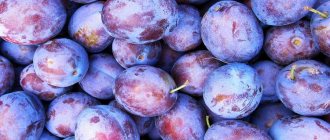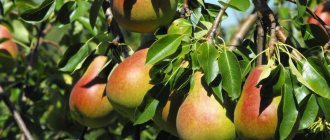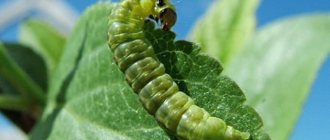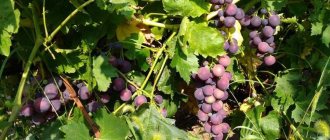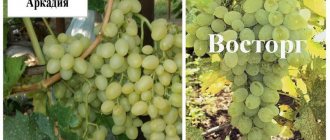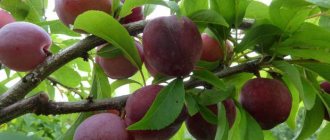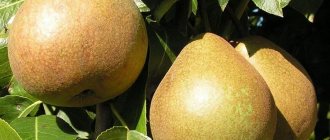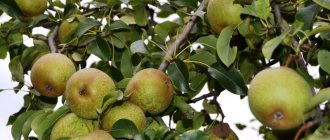Description of plum Yakhontovaya
This variety of plum is a vigorous tree. The crown is compact, spherical; foliage is average. The height of the Yakhontovaya plum reaches 5 m.
The branches are bare, straight, brown. The leaves are elongated, long, with a pointed tip, light green in color. The surface of the leaves is matte and smooth, with small teeth along the edges.
Characteristics of plum fruits of the Yakhontovaya variety:
- yellow;
- thin skin;
- round shape;
- waxy coating;
- weight – 30 g;
- yellow juicy pulp;
- small bone, easily separated;
- sweet and sour taste, rated 5 points.
The Yakhontovaya variety is recommended for planting in the Central region. Due to its high winter hardiness, cultivation in colder climates is allowed.
History of the Yakhontovaya variety
The plum appeared at the All-Russian Selection and Technological Institute of Horticulture and Nursery Growing (Moscow). Scientists Kh. K. Enikeev, S. N. Satarova, I. V. Popova and V. S. Simonov crossed the following varieties:
- large-fruited Smolinka plum with very good taste;
- A complex interspecific hybrid, Eurasia 21, bred in America, characterized by high winter hardiness and productivity.
Since 2003, the variety has been on state variety testing sites; in 2008 it was included in the Register of Breeding Achievements of the Russian Federation for the Central Region. Gardeners in Central Russia and the North-Western region successfully test the plum in real garden conditions and leave good reviews about it.
Characteristics of the variety
Yakhontovaya plum has a number of characteristics that distinguish it from other varieties: winter hardiness, productivity, convenient timing of flowering and fruiting.
Drought resistance, frost resistance
Drought resistance is rated as average. For plums, both a lack of moisture and its excess are detrimental. The irrigation scheme is chosen taking into account weather conditions.
Frost resistance of plums is high. In order for the tree to easily survive the winter, additional shelter is provided in the fall.
Pollinators of plum Yakhontovaya
The Yakhontovaya plum is partially self-fertile. For a better harvest, you need to plant several varieties of plums that bloom at the same time.
Best pollinators:
- Hungarian;
- Red early ripening;
- Memory of Timiryazev.
Important! Early plum blooms from late April to early May. The ripening period for the Yakhontovaya plum occurs in the middle and end of August.
Productivity and fruiting
The Yakhontovaya variety tree bears an average of 20–30 kg of fruit, and in good years – up to 50 kg. Fruiting is regular from year to year.
Area of application of berries
Plums are consumed fresh or used for homemade preparations. It makes delicious preserves, jam, compote, and sauce.
Resistance to diseases and pests
The Yakhontovaya variety is little susceptible to fungal diseases and pests. To protect the garden, it is recommended to periodically spray the trees.
Advantages and disadvantages of the variety
Before planting, evaluate the advantages and disadvantages of the Yakhontovaya plum.
Main advantages of the variety:
- abundant fruiting;
- good taste and appearance of the fruit;
- resistance to frost and disease.
Disadvantages of Yakhontovaya plum:
- impressive dimensions of the tree;
- partial self-fertility.
Is it worth buying a Yakhontova plum?
Yellow plum Yakhontovaya is an excellent option for planting in the Moscow region and other regions of the middle zone. Among its undoubted advantages are high quality fruits and productivity.
Pros and cons of the variety
The hybrid Yakhontova plum is characterized by advantages in the form of:
- decent taste properties of fruits;
- aesthetic appearance;
- intensive fruiting;
- frost resistance;
- resistance to most diseases of garden trees.
See also
Description of the plum moth pest, methods of control and treatment
Read
The only drawback of the variety is that its self-fertility is not complete, but partial.
Advantages and disadvantages of the yellow hybrid
Before planting a Yakhontovaya plum on a plot, you need to familiarize yourself not only with its characteristics, but also evaluate the pros and cons. This will create favorable conditions for the tree and significantly increase fruitfulness.
- Main advantages of the variety:
- high resistance to fungal diseases;
- regular stable fruiting combined with high yield;
- the high quality of the fruit allows them to be used fresh and for processing;
- increased frost resistance of wood and flower buds, which allows the plant to be cultivated even in regions with risky farming;
- ability to tolerate drought;
- early fruiting - fruiting begins already 3-4 years after planting.
The downside is the partial self-fertility of the variety. In the absence of pollinating trees, the ovary will form from only 15% of the flowers. Planting several trees is not always convenient, because they need quite a lot of space, and not all have large areas.
Character traits
Distinctive features of the Yakhontova plum are its resistance to frost and dry periods, productivity and stable fruiting.
Resistance to sub-zero temperatures and drought
Yakhontovaya plum has an average level of drought resistance. For its successful cultivation, neither moisture deficiency nor excess should be allowed. The frequency and abundance of plum watering directly depends on weather conditions in a particular region.
The resistance of Yakhontova plum is at a high level. But in order for the wintering to be painless for the garden planting, it is necessary to take care of additional shelter in the fall.
Susceptibility to diseases and insects
Due to the high degree of resistance to viral and fungal diseases, the Yakhontovaya plum is rarely susceptible to such ailments, especially clasterosporia fruit rot. Only if serious mistakes are made during the care process, the garden planting can be attacked by harmful insects such as plum aphids, shoot moths, codling moths, and black sawflies.
Pollinator varieties
Considering the partial self-fertility of the Yakhontova plum, it is recommended to plant Hungarian, Memory of Timiryazev, and Red Skorospelka nearby. The flowering phase of the Yakhontovaya variety begins at the end of April and ends at the beginning of May. Plum fruits ripen in mid-late August.
All about productivity and fruiting
On average, the productivity of a tree is 20-30 kilograms, but under favorable growing conditions it is possible to collect up to 50 kg of fruit. Gardeners choose the Yakhontova plum for the stability of the harvest from year to year.
Where are the berries used?
Fruit products are used both for fresh consumption and as raw materials for homemade preparations. Yellow plums of the Yakhontovaya variety make excellent compote, preserves, jam, and sauce. The fruits are universal.
Landing Features
Its further growth and fruiting depend on proper planting of plums. Preliminarily assess the composition and moisture content of the soil on the site.
Recommended timing
The time for planting the Yakhontovaya plum is chosen taking into account the climate in the region. If there is a risk of early autumn frosts, then the work is left until the spring. Plums are planted when the soil has warmed up, but the leaves have not yet blossomed. In the southern regions, planting is carried out in the fall, when the trees have shed their leaves.
Choosing a suitable location
The place for growing Yakhontovaya plum is chosen taking into account a number of factors:
- constant lighting;
- south or west side of the site;
- light drained soil;
- no moisture stagnation in the soil.
Attention! Plum grows in any soil except acidified soil.
The culture prefers drained fertile soils. The tree should not be located in lowlands where moisture accumulates. A flat area or an area with a slight slope is best suited for plums.
What crops can and cannot be planted nearby?
Plums are planted in groups, 2-3 different varieties. A distance of 3 m is maintained between the trees. The crop does not take root well if pears, cherries and cherries grow nearby. Neighborhood with apple trees, raspberries and currants is allowed.
Selection and preparation of planting material
For planting, choose annual seedlings of the Yakhontovaya variety, about 50 cm high and shoots 2.5 mm thick. They can be purchased from a nursery or garden center.
Comment! First you need to evaluate the plant visually. High-quality material has no damage or traces of mold. If the tree's roots are dry, you can place them in clean water before planting.
Landing algorithm
Work begins with preparing a hole, which is filled with earth and left to shrink. The aging period is 1–2 months. When planting in spring, the pit is dug in the fall. If you plant a plant immediately, then after the soil settles, the seedling will be damaged.
The procedure for planting homemade plum Yakhontovaya:
- First, make a hole measuring 0.6x0.6 m to a depth of 0.7 m.
- Fertile soil is mixed with humus, 190 g of superphosphate and 80 g of potassium salt are added.
- The earth is poured into the hole.
- When the soil settles, they begin to prepare the seedling. Add soil to the hole and place a plum on top.
- The roots of the tree are straightened and covered with fertile soil.
- The soil is compacted and the seedling is moistened with warm water.
How to plant a plum
Pay special attention to the selection of seedlings and the planting process. No amount of fertilizer or watering can save an initially weak specimen. The Yakhontovaya plum is a large variety that should be purchased in the fall as a one-year-old.
How to choose plum seedlings
Buy plum seedlings from trusted nurseries or gardening stores. There is no risk of buying the wrong variety or an infected plant. Each tree comes with a certificate with the name of the variety and an indication of age.
Pay special attention to choosing a seedling. An annual plant with a developed root system is suitable. There should be no more than 3-5 main branches and a few side branches, which are cut off after transplanting to a new location. The grafting site should be visible at the root collar.
But it’s not worth purchasing a tree that’s 4-5 years old. It will not begin to bear fruit faster, since by this age their root system has grown greatly. Therefore, in the nursery it is pruned, which complicates and increases the survival time. The plant will suffer a lot and may not produce a bountiful harvest. Also pay attention to the growing area. If varieties are brought to the northern region from the south, then in winter they may freeze. Buy only zoned varieties of plums.
It is better to purchase seedlings in the fall and bury them at home until spring. The plant is placed in a groove slightly at an angle, the roots are covered with earth, and so that it freezes in winter, it is covered with burlap and spruce branches. In the spring, those seedlings that were not purchased in the fall remain. As a rule, the choice and variety are much less.
When is the best time to plant plums?
The best time for planting in the Central and Northern regions is in the spring, when the snow melts and the ground warms up enough. If planted in the autumn months, the plants will not have time to take root and adapt to new conditions.
But in more southern regions, it is preferable to plant in October, since the summer months are extremely hot. This has a bad effect on the adaptation of the plant.
The type of root system also influences the time of planting. With the open type, you need to plant in the most favorable conditions, and with the closed type - at any time.
Where to plant plums in your summer cottage
To plant Yakhontovaya plum, select a significant part of the area. It requires a lot of space for the development of the root system, a high crown, and also space for pollinators nearby. The tree loves a lot of light and warmth, then the plums turn out juicy, sweet and large.
For Yakhontova, choose a place that is located on a slight elevation, well lit by the sun most of the day, and slightly darkened in the morning and evening by other crops or the house. But lowlands should be avoided, since they contain cool air, and in the spring the snow does not melt for a long time. This negatively affects the yield and condition of the crop.
Also make sure that there is no groundwater nearby. Because of this, in spring, during rainy weather, the area may become swampy, and the snow may remain for a long time. The minimum groundwater level is at least 1.5 meters, preferably more
The place should be protected from the north side from the cold wind. Therefore, plant plum trees next to buildings and other crops. hedge or fence. But at an optimal distance of at least 3 meters. Then Yakhontova will feel comfortable.
Fertile loamy or sandy soils with a neutral pH are suitable for growing plums. But it grows poorly on clayey, heavy soils. High acidity has a detrimental effect on tree growth and often leads to early death. It is not worth planting a plum in a place that has just been cleared of roots and stumps. The earth is depleted and poor in nutrients.
What crops should not be planted nearby?
Like any plum, Yakhontovaya gets along well next to apple, pear, raspberry, and gooseberry trees. However, it is worth remembering the size of the crop, so it is worth planting nearby plants that are also tall or shade-loving. It is also important to maintain a distance of at least 3-4 meters so that each tree and bush can develop and grow without infringing on each other’s rights.
Step-by-step landing instructions
It is best to choose plants with a closed root system for planting, that is, in containers. They are usually plastic, but can also be made from biodegradable materials. But of course they are much more expensive. Although this is a guarantee of the quality of the planting specimen, active growth and a good harvest in the future.
Prepare the area in advance in the fall or a couple of weeks in the spring. The planting hole is usually 0.5-0.6 m deep and about a meter wide. The excavated soil is mixed with fertilizers:
- peat;
- humus;
- potassium sulfate;
- superphosphate;
- wood ash.
If the soil is too acidic, deacidify with lime. Add 500 g of the substance in advance.
Before planting, place the root system of the tree in water for a couple of hours, treat it with mash, ash or potassium permanganate to disinfect it. With the root system closed, simply pour warm water and let stand for 10-15 minutes.
Planting is carried out in several stages:
- Fill the bottom of the hole with drainage. This could be crushed stone, broken brick or eggshells;
- Fill half the hole with soil mixed with fertilizer;
- Place a peg in the middle to tie the tree. Choose a tall one that will last a long time;
- Form a hill and install a seedling;
- Spread the roots on the ground and cover evenly up to the root collar. It should be 5 cm above ground level;
- Tie up the plant; if the seedling is tall, you can tie it in several places. This will form a straight trunk;
- Compact the soil around and make a watering ditch around the entire perimeter;
- Pour in 20 liters of warm, settled water.
After the water is absorbed, mulch the tree trunk circle with peat, manure, sawdust or pine needles. Further, only careful care and monitoring of the condition of the plum is required.
Aftercare for plums
Caring for the Yakhontovaya plum comes down to watering, fertilizing and pruning. Preparing for winter will help the tree survive the cold.
Diseases and pests, methods of control and prevention
Dangerous plum diseases are listed in the table.
Disease Symptoms Treatment Prevention Fruit rot Dark spots on the fruit that grow over time. Destruction of affected fruits. Spraying foliage with Bordeaux mixture. 1. Weeding, removing root shoots.
2. Trimming shoots.
3. Spraying with fungicides.
Coccomycosis Purple spots on leaves, fruits and shoots. Spraying plums with copper oxychloride solution.
You can learn about the main crop pests from the table.
Pest Signs Destruction Prevention Codling moth The caterpillar eats fruits that lose their marketable appearance and fall off. Spraying trees with a solution of the drug "Chlorophos". 1. Digging up the soil under a plum tree in the fall.
2. Collecting and burning fallen leaves.
3. Preventive spraying.
Silkworm Caterpillars feed on leaves and buds, leaving nests of cobwebs on branches. Destruction of spider nests, spraying with the drug "Entobacterin".
Diseases and pests
Yakhontovaya has high resistance to diseases, in particular fruit rot and clasterosporia. Under unfavorable conditions and improper care, it may be subject to parasite invasion.
Plum diseases - table
| Disease | Symptoms | Prevention | Help |
| Marsupiality of plum | The fruits of a diseased tree are affected, acquiring an ugly bag-like shape. | Trim the shoots regularly, do not thicken the crown. |
|
| Coccomycosis | The leaves become covered with small spots, turn yellow and fall off prematurely. At the beginning of infection, the disease destroys the berries, and subsequently the tree itself. |
|
|
| Rust | Reddish swellings appear on the leaves, resembling rust. The disease develops in rainy summers. | It is necessary to carry out proper watering and remove carrion. |
|
| Gum treatment | Amber streaks appear on the trunk. Flowing from cracks in the bark, the thick liquid quickly hardens. | Gum formation occurs when the bark is injured or there is a lack of calcium - they are fed with calcium chloride. | Cleaned wounds are disinfected with a 1% solution of copper sulfate and covered with varnish. |
Plum diseases - photo gallery
Plum marsupiality is a dangerous disease in which the fruits become inedible; plums lead to
The leaves of a tree affected by coccomycosis become covered with small spots.
Rust develops on a plum in a rainy summer
Gum discharge occurs when the cortex is injured
Plum pests - table
| Pests | Manifestations | Prevention | Control measures |
| Black sawfly | The caterpillars damage the pulp of the ovary, and the spoiled fruit falls off. | Loosen and dig up the soil. Shake off adult insects onto the film. | Trees are treated with Novaktion and Fufanon before and after flowering. |
| Plum aphid | Leaves, especially young ones, are curled and covered with small insects. | Remove root vegetation. Spray with infusion of onion peel (20 g\10 l) before and after flowering. |
|
| Shoot moth | The pest attacks leaves and ovaries. Productivity decreases. | Loosen the soil in early summer to kill caterpillars. | When the buds swell, spray with 0.1% Aktara. |
| Plum moth | The caterpillars damage the shoots and eat away the pulp of the plums. Damaged stems break and dry out. | Dig up the soil and catch caterpillars in mid-June using glue belts. |
|
Parasitic insects - photo gallery
The black plum sawfly looks like a fly
Plum aphids suck the juices of the plant
Shoot moth attacks leaves and ovaries
Plum moth caterpillars eat the pulp of the fruit
A serious threat to insect pests are starlings, flycatchers, nuthatches, swallows, and swifts. To attract them to the site, birdhouses and artificial nests are built, sunflower seeds, watermelon seeds are left for them in feeders, some cherries, rowan berries, and viburnums are left on the trees.
Why plum does not bear fruit - video
Aftercare for plums
Caring for the Yakhontovaya plum comes down to watering, fertilizing and pruning. Preparing for winter will help the tree survive the cold.
- The plum tree is watered 3–5 times per season. Water is especially important if drought occurs during the flowering and ripening period of the crop. 5 buckets of water are poured under a young tree, about 10 buckets under an adult tree.
- It is convenient to combine watering with fertilizing. In early spring, 20 g of urea, superphosphate and potassium salt are added to 10 liters of water. The solution is poured under the root of the tree. For summer feeding, a similar solution is prepared, but urea is excluded from the composition. Instead of mineral complexes, natural fertilizers are used: slurry and wood ash. Important! Pruning the Yakhontovaya plum helps to form the crown and normalize the yield.
- The plum crown is constantly pruned for 5 years. It is given a sparsely tiered form. Be sure to remove dry, frozen and broken branches. Treatment is done in spring or autumn, when sap flow in the trees is slow.
- Preparation of the Yakhontovaya plum for winter begins in late autumn. If the weather is dry, first moisten the soil. Then the trunk is hilled up and compost is poured with a layer of 10 cm. Young plants are covered with burlap or agrofibre. To protect plum trees against rodents, use mesh, metal pipes or roofing felt.
Diseases and pests, methods of control and prevention
Dangerous plum diseases are listed in the table.
Disease Symptoms Treatment Prevention Fruit rot Dark spots on the fruit that grow over time. Destruction of affected fruits. Spraying foliage with Bordeaux mixture. 1. Weeding, removing root shoots.
2. Trimming shoots.
3. Spraying with fungicides.
Coccomycosis Purple spots on leaves, fruits and shoots. Spraying plums with copper oxychloride solution.
You can learn about the main crop pests from the table.
Pest Signs Destruction Prevention Codling moth The caterpillar eats fruits that lose their marketable appearance and fall off. Spraying trees with a solution of the drug "Chlorophos". 1. Digging up the soil under a plum tree in the fall.
2. Collecting and burning fallen leaves.
3. Preventive spraying.
Silkworm Caterpillars feed on leaves and buds, leaving nests of cobwebs on branches. Destruction of spider nests, spraying with the drug "Entobacterin".
Pollinators and care
The pollination process often becomes a “bottleneck” when growing this crop, as it depends on many factors: air temperature, weather during flowering, and the presence of bees. Therefore, an important indicator of the value of a variety is its high level of self-fertility. Yakhontovaya itself acts as a high-quality pollinator, and its proximity to Hungarian, Pamyatya Timiryazev and Skorospelka red is useful for it.
It also tolerates dry periods well, which is due to the significant size of the tree. The root system of the plant goes deep and reaches moisture there.
Like any fruit, plum loves attention and care. In the spring, before the buds bloom, it is pruned. Dried and thickening branches are removed completely, and normal ones are shortened. Do not forget about timely fertilizing with balanced fertilizers.
To free plants from annoying aphids in the spring, use the drug Komandor and other insecticides. In late spring - early summer, it is useful to generously spray the leaves with Bordeaux mixture and leave the preparation to dry. This helps with a whole range of problems. Pheromone traps that are suspended in the crown of a tree are effective against the ubiquitous plum moth.
It is very useful to carry out an agricultural practice called mulching. It reduces the growth of weeds and temperature changes in the soil around the tree trunk, and also supplies the plant with nitrogen during rotting.
Tips for harvesting and storing crops
Plums ripen in mid or late August (depending on the weather in the summer). About 70 kg is harvested from one tree; fruiting lasts about a month. Harvesting is carried out several times as they ripen; the berries are removed in dry weather. If they are to be stored, plums should be harvested 5 days before full ripeness. In a week they will acquire the appropriate taste, aroma and color. The Yakhontovaya plum is good not only in its fresh form, it makes wonderfully tasty preparations for the winter
For the harvest, you need to prepare the boxes by placing paper on the bottom. The plums are laid in 3 layers, sprinkled with sawdust or finely torn paper, placed in the refrigerator and stored for three weeks at 5°C and 90% humidity. You should not keep the harvest at a temperature of 0°C; in such conditions, the plum pulp darkens.
The fruits are processed into jam, jams, preserves, compotes, marmalade, and marshmallows. Also, plums of this variety are consumed fresh and frozen.
Reviews
Let’s find out what experienced gardeners think about this plum variety.
- Boris, Ryazan: “I planted the Yakhontova plum 6 years ago, it began to bear fruit in the fourth year. I am pleased with the harvest - the fruits are large, very beautiful, large, juicy and sweet, great for jams, jams, desserts, you can also make liqueur. Care is a little more thorough than other varieties, but nothing too complicated. I cover it for the winter; at least we are considered to be in the middle zone, but the frosts can be severe. The tree still needs to be grafted with dwarf plum species, otherwise it will grow huge and the harvest will not be harvested. Overall, I’m pleased - I’ve never seen such harvests and such tasty plum berries.”
- Alla, Stary Oskol: “I’ve been doing gardening for a long time - I have a residential dacha with a large plot. I have several varieties of plums: Yakhontovaya is my favorite among them. This tree produces such tasty and juicy fruits that it is difficult to resist eating them all at once. Joy for the grandchildren and vitamins for the winter. The plum requires care, but I’m retired, so I mostly work in the garden. It is necessary to water, and feed, and be sure to prune, and it is better to cover for the winter. I recommend this variety, because among the domestic varieties, Yakhontova, in my opinion, has the most delicious fruits.”
It is also worth learning more about existing reviews about the Blue Gift plum.
So, we looked at the features of growing the Yakhontovaya plum variety. As you can see, this brainchild of domestic selection has truly noteworthy properties and characteristics. It’s not without reason that this variety has more and more fans among gardeners every year. Now you can join this chorus of enthusiastic admirers and grow a magnificent Yakhont plum on your plot with the help of our tips.
The plum blossoms, but does not bear fruit. What to do?
There may be several reasons for this:
- In order not to consider others, you need to try to remember the name of the plum variety that was purchased and has already entered the fruiting age. Why is it important? Initially, the plum is a self-sterile plant. This means that cross-pollination is necessary to obtain ovaries.
- The second reason may be improper planting of the plum when its root collar was buried. In this situation, the bark begins to rot, and all the plant’s strength goes into fighting this scourge.
- Since the plum does not tolerate frost very well, you need to make sure that it is not frozen. In this situation, a barren flower is inevitable. More often, however, fruits still form on some branches.
- The reason may be return frosts at the time when the plum blossoms. Yellowed (frozen) pistils will be evidence of this. And the fruit, even if it sets, will fly around very quickly.
- Experienced gardeners name several other weather reasons for poor fruit set: dry spring, fog, high humidity, low temperature and strong wind.
- The most incredible, but still not excluded from the list, would be the reason for the yellow plum sawfly eating the center of flowers. The beetle eats away the passages in the buds, damaging them, thereby preventing the ovary from developing. Even with a very developed sawfly colony, when almost every flower is damaged, ovaries develop. They may then fall off, or the fruit may not be fully formed, but the ovaries will still be there.
- A plum may not develop an ovary if it lacks nutrition. Timely feeding, alternating organic matter and minerals, will help the tree.
- Excessive shading of a tree can cause barren flowers. To eliminate the cause, you need to cut down around the tree and timely cut out excess branches.
- The proximity of groundwater will prevent the plum from setting fruit. Swampy soils are therefore not the best for plants; irrigation work is necessary.
